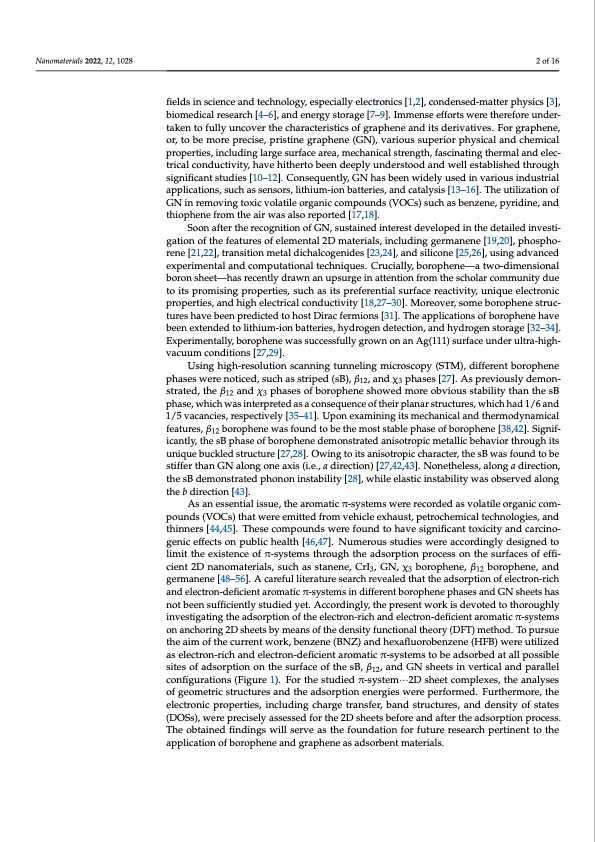
PDF Publication Title:
Text from PDF Page: 002
Nanomaterials 2022, 12, 1028 2 of 16 fields in science and technology, especially electronics [1,2], condensed-matter physics [3], biomedical research [4–6], and energy storage [7–9]. Immense efforts were therefore under- taken to fully uncover the characteristics of graphene and its derivatives. For graphene, or, to be more precise, pristine graphene (GN), various superior physical and chemical properties, including large surface area, mechanical strength, fascinating thermal and elec- trical conductivity, have hitherto been deeply understood and well established through significant studies [10–12]. Consequently, GN has been widely used in various industrial applications, such as sensors, lithium-ion batteries, and catalysis [13–16]. The utilization of GN in removing toxic volatile organic compounds (VOCs) such as benzene, pyridine, and thiophene from the air was also reported [17,18]. Soon after the recognition of GN, sustained interest developed in the detailed investi- gation of the features of elemental 2D materials, including germanene [19,20], phospho- rene [21,22], transition metal dichalcogenides [23,24], and silicone [25,26], using advanced experimental and computational techniques. Crucially, borophene—a two-dimensional boron sheet—has recently drawn an upsurge in attention from the scholar community due to its promising properties, such as its preferential surface reactivity, unique electronic properties, and high electrical conductivity [18,27–30]. Moreover, some borophene struc- tures have been predicted to host Dirac fermions [31]. The applications of borophene have been extended to lithium-ion batteries, hydrogen detection, and hydrogen storage [32–34]. Experimentally, borophene was successfully grown on an Ag(111) surface under ultra-high- vacuum conditions [27,29]. Using high-resolution scanning tunneling microscopy (STM), different borophene phases were noticed, such as striped (sB), β12, and χ3 phases [27]. As previously demon- strated, the β12 and χ3 phases of borophene showed more obvious stability than the sB phase, which was interpreted as a consequence of their planar structures, which had 1/6 and 1/5 vacancies, respectively [35–41]. Upon examining its mechanical and thermodynamical features, β12 borophene was found to be the most stable phase of borophene [38,42]. Signif- icantly, the sB phase of borophene demonstrated anisotropic metallic behavior through its unique buckled structure [27,28]. Owing to its anisotropic character, the sB was found to be stiffer than GN along one axis (i.e., a direction) [27,42,43]. Nonetheless, along a direction, the sB demonstrated phonon instability [28], while elastic instability was observed along the b direction [43]. As an essential issue, the aromatic π-systems were recorded as volatile organic com- pounds (VOCs) that were emitted from vehicle exhaust, petrochemical technologies, and thinners [44,45]. These compounds were found to have significant toxicity and carcino- genic effects on public health [46,47]. Numerous studies were accordingly designed to limit the existence of π-systems through the adsorption process on the surfaces of effi- cient 2D nanomaterials, such as stanene, CrI3, GN, χ3 borophene, β12 borophene, and germanene [48–56]. A careful literature search revealed that the adsorption of electron-rich and electron-deficient aromatic π-systems in different borophene phases and GN sheets has not been sufficiently studied yet. Accordingly, the present work is devoted to thoroughly investigating the adsorption of the electron-rich and electron-deficient aromatic π-systems on anchoring 2D sheets by means of the density functional theory (DFT) method. To pursue the aim of the current work, benzene (BNZ) and hexafluorobenzene (HFB) were utilized as electron-rich and electron-deficient aromatic π-systems to be adsorbed at all possible sites of adsorption on the surface of the sB, β12, and GN sheets in vertical and parallel configurations (Figure 1). For the studied π-system···2D sheet complexes, the analyses of geometric structures and the adsorption energies were performed. Furthermore, the electronic properties, including charge transfer, band structures, and density of states (DOSs), were precisely assessed for the 2D sheets before and after the adsorption process. The obtained findings will serve as the foundation for future research pertinent to the application of borophene and graphene as adsorbent materials.PDF Image | Borophene and Pristine Graphene 2D Sheets

PDF Search Title:
Borophene and Pristine Graphene 2D SheetsOriginal File Name Searched:
nanomaterials-12-01028-v2.pdfDIY PDF Search: Google It | Yahoo | Bing
CO2 Organic Rankine Cycle Experimenter Platform The supercritical CO2 phase change system is both a heat pump and organic rankine cycle which can be used for those purposes and as a supercritical extractor for advanced subcritical and supercritical extraction technology. Uses include producing nanoparticles, precious metal CO2 extraction, lithium battery recycling, and other applications... More Info
Heat Pumps CO2 ORC Heat Pump System Platform More Info
| CONTACT TEL: 608-238-6001 Email: greg@infinityturbine.com | RSS | AMP |